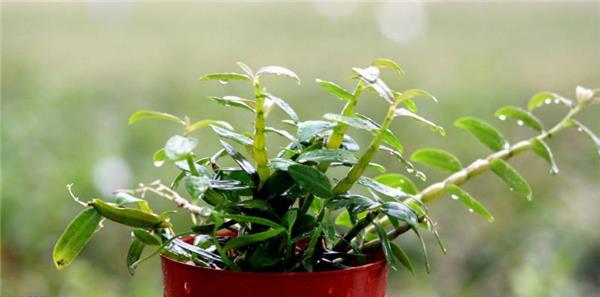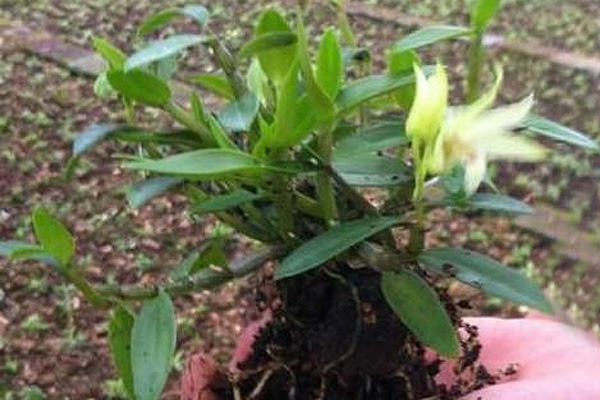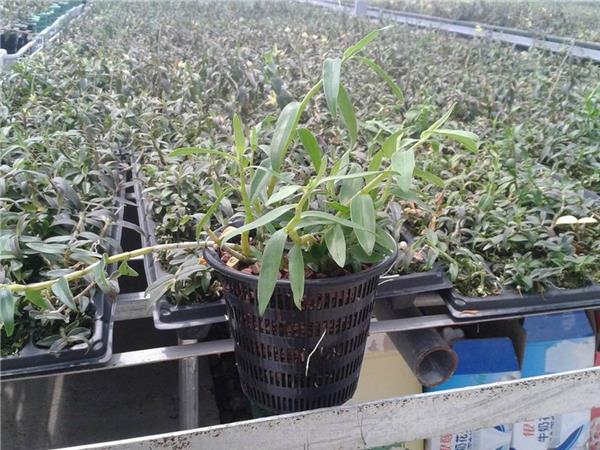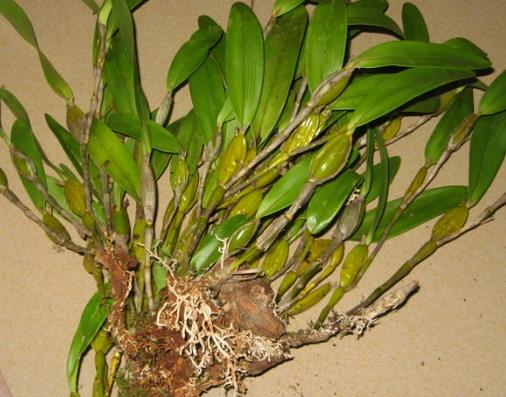[Dendrobium candidum planting] detailed explanation of the planting method of Dendrobium candidum
Nowadays many people like to plant some fresh and green plants indoors. Because planting green plants can not only purify indoor air and protect human health, but also beautify the environment and make the whole room poetic. So growing plants indoors has a lot of benefits. But can you plant Dendrobium candidum indoors? If not, please read the following article.

Preparation of cultivation substrate
The suitable substrate should be selected for transplanting tissue culture seedlings of Dendrobium candidum. The root of Dendrobium candidum is aerial root, which has obvious aeration and shallow root, so it is suitable for the matrix to be loose and permeable, good drainage, not easy to cause bacteria and insect pests. A single substrate is difficult to meet the requirements of water retention and air permeability at the same time. Water moss, limestone, broken brick, sawdust powder, bark, shavings, fern root, board edge, fungus bran and wood chaff can be selected as transplanting substrate. Due to the long fermentation time of sawdust and other organic substrates with high C / N ratio, Gymboree matrix nutrient soil starter can be used to ferment mixed materials, which can not only shorten the fermentation time, but also transform the nutrients in the materials through high temperature fermentation. as a result, the amount of fertilizer used in the later stage is reduced, and the fermentation material also contains many beneficial microorganisms, which can form a protective layer around the root system of Dendrobium candidum. Effective prevention of root diseases, in addition, microbial metabolites such as cytokinin, gibberellin, indoleacetic acid can also stimulate root growth.) The best matrix ratio in practical production is peat ∶ bark ∶ fine shavings = 2 ∶ 4 ∶ 4. Due to the fine particles and poor permeability of fine sawdust, it is easy to cause hardening, which limits the root growth of Dendrobium candidum.

Timely transplanting
The main results are as follows: (1) the best season for transplanting should be when the daily average temperature is 15ml / 30 ℃, and the temperature is too low or too high. Generally speaking, in the main producing areas of Dendrobium candidum, it can be planted except in the coldest season. Planting Dendrobium candidum in greenhouse, the Spring Equinox to Qingming, and the Autumn Equinox, transplanting in these two periods is the transplanting period with the highest survival rate.
(2) take out the tissue culture seedling carefully, do not damage and break the root system, rinse the culture medium of the seedling root gently after the seedling comes out of the bottle. If transplanting with medium, the nutrient components of the medium are easy to cause bacteria and lead to rotten roots, resulting in a lower survival rate. After cleaning, the tissue culture seedlings were soaked in 500 ml diluted 500-800 times solution of Gymboree root seedlings for 15 minutes. (Gymboree root seedlings contain active rooting agents, virus inhibitors and BYM microbial fermentation broth. Dipping in the root can reduce the root disease of the seedling, promote the growth of fibrous root and improve the root absorption capacity.) after soaking, put the seedling on a water-absorbing object Dry naturally under scattered light for 5-7 hours.
Moderate temperature
Planting Dendrobium candidum generally requires room temperature up to 0 ℃ and growth temperature up to 15 ℃. In summer, pay attention to shading and ventilation, often watering or spraying to moisturize and cool down; in winter, pay attention to indoor temperature and heat preservation for plants.
Appropriate humidity
The planting requirement of Dendrobium candidum is appropriate, and the adjustment of humidity varies according to the temperature. High temperature requires high humidity and low temperature requires low humidity. During the peak growth period, the indoor air humidity should be kept at 60%, 90%.

The water quality is moderate
In the cultivation of Dendrobium candidum, it is required to use weak acid water or neutral water, and the substrate used in cultivation is easy to be breathable, easy to leak and have many voids.
Suitable site
The cultivation site of Dendrobium candidum requires good ventilation facilities. The room should be warm, moist, weak light and ventilated.
Propagation technique of Dendrobium candidum
The reproduction methods of Dendrobium can be divided into two categories: sexual reproduction and asexual reproduction.
1. Sexual reproduction is seed reproduction. Dendrobium seeds are very small, each capsule has about 20000, yellow powder, usually does not germinate, only in sufficient nutrients, suitable humidity, moderate light conditions can germinate and grow, generally need to be cultured in the tissue culture room. However, although the reproduction coefficient of Dendrobium is very high, the success rate of sexual reproduction is very low.
2. Asexual reproduction
The main results are as follows: (1) ramet propagation is carried out in spring or autumn, and it is better before Dendrobium germinated at the end of March or early April. The 1-year-old and 2-year-old plants with good growth, no diseases and insect pests, developed roots and sprouts were selected as seed plants, which were uprooted, withered branches and cutting techniques were removed, and the long fibrous roots were cut off. The old roots were retained about 3 meters, and were divided into several clumps according to the number of stems. Each cluster must have 4 stems and 5 branches, which can be used as seed stems.

(2) cuttage propagation: it is carried out in spring or summer, and it is better from May to June. Select the three-year-old strong growing plant, take its full and round stem segment, each segment retains 4-5 nodes, about 15-25 cm long, inserted in vermiculite or river sand, the depth is not down to the stem, wait for the axillary buds on the stem to germinate, grow white air roots, and then transplant. Generally, in the selection of materials, the upper stem segment is the main, because of its top advantage, high survival rate, more buds, rapid growth and development.
(3) High bud propagation: most of them are carried out in spring or summer, mainly in summer. Dendrobium plants that are more than three years old will sprout axillary buds, also known as tall buds, on the stems every year, and grow aerial roots to become seedlings, which can be cut off for transplanting when they grow to 5-7 meters.
(4) tissue culture and propagation in vitro: Dendrobium nobile can be cultured and propagated rapidly by the following methods. After routine disinfection, the leaves, tender stems and roots of Dendrobium nobile were cut into 0.5 × 10 ~ (- 1) rice as explants, using MS and B5 as the basic medium, and a variety of media supplemented with different combinations of plant hormones, such as NAA (0.05~1.5mg/L), IAA (0.2~1.0mg/L), 6-BA (1.0~5.0mg/L), pH5.6~6.0, and the culture temperature was 25 ℃ ~ 28 ℃. Tissue culture was carried out under the condition of light intensity 1800~1900lx after 9 hours of light exposure every day. After 19 days, the buds appeared in the stems and leaves, and after about 1 month, the buds elongated and the tip bifurcated. After 2 months, the buds grew into test-tube plantlets with a height of about 2.0-2.7 cm and 4-8 leaves. However, the segments of leaves and roots did not change. It was also found that in different combinations of culture medium, MS had obvious advantages over B5 basic medium in growth rate.
The above points are the techniques of planting Dendrobium candidum. Have you learned it? If you learn it, you might as well try to plant it at home, because Dendrobium candidum is a precious plant, which will be of great help to everyone's health.
(2) cuttage propagation: it is carried out in spring or summer, and it is better from May to June. Select the three-year-old strong growing plant, take its full and round stem segment, each segment retains 4-5 nodes, about 15-25 cm long, inserted in vermiculite or river sand, the depth is not down to the stem, wait for the axillary buds on the stem to germinate, grow white air roots, and then transplant. Generally, in the selection of materials, the upper stem segment is the main, because of its top advantage, high survival rate, more buds, rapid growth and development.
(3) High bud propagation: most of them are carried out in spring or summer, mainly in summer. Dendrobium plants that are more than three years old will sprout axillary buds, also known as tall buds, on the stems every year, and grow aerial roots to become seedlings, which can be cut off for transplanting when they grow to 5-7 meters.
(4) tissue culture and propagation in vitro: Dendrobium nobile can be cultured and propagated rapidly by the following methods. After routine disinfection, the leaves, tender stems and roots of Dendrobium nobile were cut into 0.5 × 10 ~ (- 1) rice as explants, using MS and B5 as the basic medium, and a variety of media supplemented with different combinations of plant hormones, such as NAA (0.05~1.5mg/L), IAA (0.2~1.0mg/L), 6-BA (1.0~5.0mg/L), pH5.6~6.0, and the culture temperature was 25 ℃ ~ 28 ℃. Tissue culture was carried out under the condition of light intensity 1800~1900lx after 9 hours of light exposure every day. After 19 days, the buds appeared in the stems and leaves, and after about 1 month, the buds elongated and the tip bifurcated. After 2 months, the buds grew into test-tube plantlets with a height of about 2.0-2.7 cm and 4-8 leaves. However, the segments of leaves and roots did not change. It was also found that in different combinations of culture medium, MS had obvious advantages over B5 basic medium in growth rate.
The above points are the techniques of planting Dendrobium candidum. Have you learned it? If you learn it, you might as well try to plant it at home, because Dendrobium candidum is a precious plant, which will be of great help to everyone's health.
- Prev

[how to raise money grass] matters needing attention in the cultivation of money grass
[how to raise money grass] matters needing attention in the cultivation of money grass
- Next

[asparagus planting method] what is the asparagus planting method?
[asparagus planting method] what is the asparagus planting method?
Related
- Wuhan Hospital Iron Tree Blooming Result Was Instantly Frightened by the Gardener Master
- Which variety of camellia is the most fragrant and best? Which one do you like best?
- What is the small blue coat, the breeding methods and matters needing attention of the succulent plant
- Dormancy time and maintenance management of succulent plants during dormancy
- Minas succulent how to raise, Minas succulent plant pictures
- What are the varieties of winter succulent plants
- How to raise succulent plants in twelve rolls? let's take a look at some experience of breeding twelve rolls.
- Attention should be paid to water control for succulent plants during dormant period (winter and summer)
- Watering experience of twelve rolls of succulent plants
- Techniques for fertilizing succulent plants. An article will let you know how to fertilize succulent plants.

